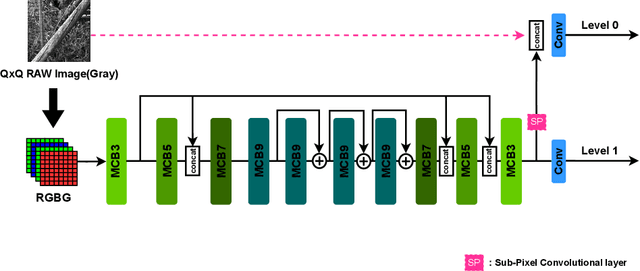Dongil Ryu
Fully Quantized Always-on Face Detector Considering Mobile Image Sensors
Nov 02, 2023Abstract:Despite significant research on lightweight deep neural networks (DNNs) designed for edge devices, the current face detectors do not fully meet the requirements for "intelligent" CMOS image sensors (iCISs) integrated with embedded DNNs. These sensors are essential in various practical applications, such as energy-efficient mobile phones and surveillance systems with always-on capabilities. One noteworthy limitation is the absence of suitable face detectors for the always-on scenario, a crucial aspect of image sensor-level applications. These detectors must operate directly with sensor RAW data before the image signal processor (ISP) takes over. This gap poses a significant challenge in achieving optimal performance in such scenarios. Further research and development are necessary to bridge this gap and fully leverage the potential of iCIS applications. In this study, we aim to bridge the gap by exploring extremely low-bit lightweight face detectors, focusing on the always-on face detection scenario for mobile image sensor applications. To achieve this, our proposed model utilizes sensor-aware synthetic RAW inputs, simulating always-on face detection processed "before" the ISP chain. Our approach employs ternary (-1, 0, 1) weights for potential implementations in image sensors, resulting in a relatively simple network architecture with shallow layers and extremely low-bitwidth. Our method demonstrates reasonable face detection performance and excellent efficiency in simulation studies, offering promising possibilities for practical always-on face detectors in real-world applications.
Efficient Unified Demosaicing for Bayer and Non-Bayer Patterned Image Sensors
Jul 20, 2023Abstract:As the physical size of recent CMOS image sensors (CIS) gets smaller, the latest mobile cameras are adopting unique non-Bayer color filter array (CFA) patterns (e.g., Quad, Nona, QxQ), which consist of homogeneous color units with adjacent pixels. These non-Bayer sensors are superior to conventional Bayer CFA thanks to their changeable pixel-bin sizes for different light conditions but may introduce visual artifacts during demosaicing due to their inherent pixel pattern structures and sensor hardware characteristics. Previous demosaicing methods have primarily focused on Bayer CFA, necessitating distinct reconstruction methods for non-Bayer patterned CIS with various CFA modes under different lighting conditions. In this work, we propose an efficient unified demosaicing method that can be applied to both conventional Bayer RAW and various non-Bayer CFAs' RAW data in different operation modes. Our Knowledge Learning-based demosaicing model for Adaptive Patterns, namely KLAP, utilizes CFA-adaptive filters for only 1% key filters in the network for each CFA, but still manages to effectively demosaic all the CFAs, yielding comparable performance to the large-scale models. Furthermore, by employing meta-learning during inference (KLAP-M), our model is able to eliminate unknown sensor-generic artifacts in real RAW data, effectively bridging the gap between synthetic images and real sensor RAW. Our KLAP and KLAP-M methods achieved state-of-the-art demosaicing performance in both synthetic and real RAW data of Bayer and non-Bayer CFAs.
PyNET-QxQ: A Distilled PyNET for QxQ Bayer Pattern Demosaicing in CMOS Image Sensor
Mar 08, 2022



Abstract:The deep learning-based ISP models for mobile cameras produce high-quality images comparable to the professional DSLR camera. However, many of them are computationally expensive, which may not be appropriate for mobile environments. Also, the recent mobile cameras adopt non-Bayer CFAs (e.g., Quad Bayer, Nona Bayer, and QxQ Bayer) to improve image quality; however, most deep learning-based ISP models mainly focus on standard Bayer CFA. In this work, we propose PyNET-QxQ based on PyNET, a light-weighted ISP explicitly designed for the QxQ CFA pattern. The number of parameters of PyNET-QxQ is less than 2.5% of PyNET. We also introduce a novel knowledge distillation technique, progressive distillation, to train the compressed network effectively. Finally, experiments with QxQ images (obtained by an actual QxQ camera sensor, under development) demonstrate the outstanding performance of PyNET-QxQ despite significant parameter reductions.
 Add to Chrome
Add to Chrome Add to Firefox
Add to Firefox Add to Edge
Add to Edge